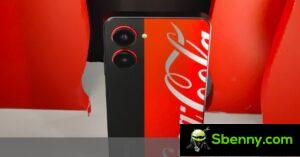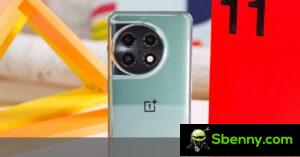Infinix ZeroBook 13 is the successor to the previous generation ZeroBook 12 model. If you’re wondering whether the numbering represents notebook generation or display size, it’s neither. Instead, the number refers to the generation of the internal Intel CPU, with the new ZeroBook 13 equipped with Intel’s latest 13th generation models.

The model we have here is the flagship of the series and also the most interesting of all. Featuring a Core i9-13900H, 32GB memory and 1TB SSD, the ZeroBook 13 is equipped like a high-end notebook but comes at an astonishing price tag of INR 81,990 ($989). This makes it the most powerful and well-equipped notebook in its price range, with most other models of similar specs priced well above INR 100k.
Proġett
The ZeroBook 13 has the same basic design as the previous generation model. Largely inspired by the MacBook Pro models of yesteryear, the design features a silver aluminum frame. The lid has some flashy markings on it with an illuminated Zero logo.

The choice of logo seemed rather curious at first as most people would not be familiar with this brand. “Infinix” itself isn’t a particularly well-known name in the notebook space, let alone their “Zero” sub-brand. When asked about it, Infinix said they wanted to showcase what is essentially their halo branding, but finally admitted it would have made more sense to have the Infinix name there instead.
I was also less sure about the conspicuous marks on the lid for what should be a mature, professional grade product. Maybe it’s a way to stand out from the crowd, but it’s quite aggressive and distracts from the otherwise clean look.
Lift the lid and you’re greeted by the now-familiar black chiclet keyboard and large trackpad with a tasteful speaker grille on the side. The interior is definitely cleaner and less aggressive, if derivative.

On the left are two USB-C ports, only one of which supports laptop charging. There’s also a USB-A 3.0 port with HDMI 1.4 and a DC power connector for the charger.

On the right side is another USB-A 3.0 port along with a microSD slot, headphone jack, and a slider that switches between three performance profiles.

The bottom of the laptop has ventilation for the dual internal fans. Air is drawn in from the back and expelled through a vent near the zipper. I’m not particularly fond of this method of exhausting the hot air as it causes turbulence as the air escapes from this narrow space and also the vent closes when the lid is closed which makes using the notebook with the display unsuitable closed and connected to an external display.

One cool design feature is a row of red LEDs, which light up whenever you put the laptop into Overdrive performance mode using the switch on the side. The other two profiles receive no illumination. I wouldn’t have minded green lighting for Economy mode and white lighting for the default Balanced profile.

The ZeroBook 13 is a reasonably well built machine. The aluminum construction gives it a premium look and feel. The lid has nice tension and moves sharply with minimal flex. The only part of the design that feels a bit flimsy is the flex in the area above the keyboard. This does not affect the area underneath as there is no flex on the actual keyboard.
Wiri u ħoss
The ZeroBook 13 has a 15.6-inch IPS panel, 1920×1080 60Hz resolution. Infinix claims 100% sRGB coverage and 400 nits of peak brightness. There is no HDR support nor is there a touchscreen.

In my testing, I found the gamut coverage for sRGB to be around 98%, which is pretty good. However, both Adobe RGB and DCI-P3 were limited to 76%, making the display unsuitable for wide color work.
The display has very good color calibration, with an average dE of 0.7 in the Color Checker test. Gamma compliance also followed the 2.2 standard well. However, the white point of the display was set too cool at 8500K, which is definitely too blue compared to the D65 standard of 6504K.




Show performance
The display manages to get reasonably bright indoors, with a tested maximum brightness of 370 nits. Contrast was typical for an LCD without full array local dimming, coming in at 700:1. Viewing angles were great and there were no obvious panel inconsistencies. However, there is some light in the lower left corner when viewing the display on a black screen in complete darkness.
Finally, the display is also limited to just 60Hz. Performance in motion isn’t great but it isn’t terrible either, and the image looks decently clear in motion for things like scrolling through web pages and photos.
Overall, the ZeroBook 13’s display is fine for everyday use, but I expected better from a machine with professional aspirations. You will need to do hardware calibration for better white point and grayscale accuracy, and even then you can’t do wide color work.
Audio on the ZeroBook 13 comes from a quad speaker system with 2 low-frequency drivers and 2 high-frequency drivers. Despite the inclusion of low-frequency drivers and the DTS Audio Processing app, the sound from the speakers is still rather tinny. The speakers get quite loud but the sound is never balanced enough to make them usable for music or movies.

Aside from the grilles next to the keyboard, the speakers also seem to shoot out of vents at the bottom of the laptop. This causes the sound to become muffled if you hold the laptop on a soft surface as opposed to a desk. You shouldn’t be doing this anyway because it locks the fans down, but we know everyone still does it no matter how often you tell them not to.
Keyboard u trackpad
The ZeroBook 13’s chiclet-style keyboard has a familiar layout and design. Despite the notebook’s increased width, you don’t get a numeric keypad. Instead, there’s a row of scroll buttons to the right.
The function buttons do double duty with hotkey functions when you hold down the Fn key. There is no way to change these keys to make the secondary function the default, so if you use secondary shortcuts often you should always press the Fn key.

The keyboard on the ZeroBook 13 is comfortable to use with decent travel and feedback. The keys stay put and there is no wobbling or rattling. The keys are a bit smaller, but personally that wasn’t a problem for me. Those used to larger keyboards or have bigger fingers might disagree.
The keyboard features white LED backlighting. The lighting is quite even and has two brightness levels. Unfortunately, it is not possible for the lighting to remain on permanently as it always switches off automatically after a few seconds of inactivity. It also turns off completely if the notebook has been idle for a while and you have to use the hotkey to turn it on manually.
The large touchpad below the keyboard has a glass surface and feels smooth to the touch. The trackpad is hinged at the top, meaning it’s more clickable at the bottom edge and then progressively stops moving the higher you go.

The trackpad on the ZeroBook 13 was very inconsistent. It doesn’t actually track well, and it also doesn’t respond well to quick movements or gestures. Sometimes it also gets extremely erratic and the only way to fix this is to restart the machine. I had to resort to using a mouse full time as it got too nasty to use after a while.
Hardware and connectivity
The ZeroBook 13 series is equipped with the latest 13th generation Intel CPUs, including Core i5-13500H, Core i7-13700H and Core i9-13900H.
Our review unit came with the 13900H, a 14-core processor with 6 performance cores and 8 efficiency cores with a total of 20 threads. This chip can boost up to 5.4GHz and consume up to 115W under load. You also get integrated Intel Iris Xe graphics, which is the only GPU on this machine.

Our test setup was also fully loaded. There was 32GB of 5200MHz LPDDR5X memory with 1TB PCIe 4.0 NVMe M.2 SSD. While the memory isn’t upgradeable, there is a slot for an additional M.2 SSD.
As mentioned above, you get two USB-C ports, two USB-A ports, full-size HDMI 1.4, and a headphone jack. There’s also 2×2 tri-band Wi-Fi 6E and Bluetooth 5.2. You also get a 1080p webcam and built-in microphone.
Prestazzjoni
The ZeroBook 13 performs very well, courtesy of the 13900H on our review unit. The CPU never leaves you craving for more performance in day-to-day tasks, so everything from web browsing, working with documents, watching media and switching between applications is fast and effortless.
Where the ZeroBook 13 lacks is graphics horsepower. The integrated Intel Xe Graphics GPU isn’t capable of doing much more than video decoding and easier image and video editing. Working with more complex or RAW video files proves to be a bit too much for the system and it’s best if you stick to simpler HD projects with fewer effects. Even 3D rendering in Blender is difficult without native GPU rendering API support like CUDA on Nvidia GPUs, causing all projects to run on the CPU. Audio production projects will also need more than the 32GB memory provided by the system.
| Cinebench R23 | Qalba waħda | 1992 |
| Multikore | 15952 | |
| Multicore (10 minutes) | 14923 | |
| 6 Geekbench | Qalba waħda | 2797 |
| Multikore | 14343 | |
| OpenCL | 17420 | |
| Mixer | Classroom | 06:30:96 |
| 7 zips | Kompressjoni | 96266 |
| Dekompressjoni | 97790 | |
| Kuruna 10 | Ray(s). | 4999435 |
| PCMark 10 | essenzjali | 11730 |
| Produttività | 8260 | |
| Digital content creation | 8082 | |
| Browser Benchmarks (Edge) | Jetstream 2 | 300,528 |
| Spidometru | 314 | |
| Ottan 2.0 | 94295 |
The game is tough but not impossible. Xe graphics could run older games like CS:GO, Valorant and GTA V as well as any 2D game over 100 FPS. However, most new 3D AAA games are out of the question.
This limits the ZeroBook 13’s usability to primarily a very capable office machine. The lack of dedicated graphics and higher memory options mean you’re unlikely to be able to do much production work, and the display isn’t accurate enough for this either.

The cooling of the ZeroBook 13 was good enough for onboard computing performance. The fans become audible and even stop rather abruptly when the temperature drops below a threshold, making them hard to ignore. However, the machine doesn’t lose much of its performance even when running at full throttle, which is a testament to the cooling on offer. The keyboard and trackpad area also remain comfortable to touch under load.
Battery ħajja
The ZeroBook 13 has a 70Wh battery, which Infinix claims provides “all day” battery life without going into details.
In my testing, I got 5-6 hours of use from the machine in the default Balanced mode while working on this review and also while watching the occasional YouTube video. The display was set to 70% brightness and all audio played through the notebook speakers.
Eco mode should be able to get you at least 8 hours of battery life with the display dimmed, which probably fits an all-day definition of battery life. Overall, the battery life of the ZeroBook 13 is acceptable if not great.
Prezzijiet
The Core i9 model we tested here is priced at INR 81,990 and is only available in a configuration with 32GB of memory and 1TB of storage. The i7 model is available in 16GB + 512GB and 32GB + 1TB configurations for INR 64,990 and INR 69,990, respectively. The i5 variant is only available in 16GB + 512GB configuration for INR 51,990.
konklużjoni
The ZeroBook 13 is a good notebook for office work and students. It has a large, bright display that’s great for documents, web browsing, and watching content. The keyboard is comfortable enough, and the battery is good enough to get you through most of the day.

The lack of discrete graphics and a more color-accurate, high-refresh-rate display make the ZeroBook 13 unsuitable for content production work and gaming. The trackpad is also extremely unreliable and requires more software to be usable.
At INR 81,990 for the i9 model, the ZeroBook 13 is well priced compared to its peers, but I would advise most buyers to consider the cheaper i7 model instead as it should be perfectly adequate for the use cases this machine is for. it is suitable and also has better battery life.







Ibda Thread ġdid